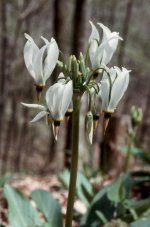 Dodecatheon meadia
Dodecatheon meadia
"Shooting Stars"! What a perfect choice of a common name for an uncommon plant. The fragrant white flowers do have kind of a meteoric look of movement as they point pendulously to the ground. As one of my favorite plants in one of my favorite families, Dodecatheon meadia has never disappointed me as a reliable bloomer and an easy keeper. I grow it under a canopy of Robinia pseudoa-cacia, "Black Locust" trees. This tree is very late in the Spring to refoliate. Is that a word? Well, you know what I mean. My point is that Dodecatheon meadia gets a good bit of bright, dappled sunlight early in the season and then, as it is going dormant, more shade. The flower stems emanate from a basal plant that dies back soon after flowering, but you then get secondary interest from the 12"- 24" stems that bear the seed pods. These stems persist all Summer and Autumn as the seeds ripen.
In Greek, the word Dodeca means twelve and Theos means God. I was always under the erroneous impression that this reference was to twelve of some floral part or seed capsule or some other botanical aspect of the plant. But I now find that it is a name given by Gaius Plinius Secundas, better known as Pliny or Pliny the Elder, 23-79 AD. Wow, they had nicknames even back in those days! Pliny was a Roman encyclopedist and author of Historia naturalis. He was a soldier, biographer, historian, collector, and student of the natural world in all its aspects, stars and planets, plants and animals, land and sea. It turns out that he actually gave this name to the Primrose which was believed to be under the care of the "twelve superior gods". You can read more about Pliny at: http://www.abila.org/pliny.html The specific epithet meadia is in honor of Dr. Richard Mead, 1673-1754, an English physician who was physician to King George III and intimate of Sir Isaac Newton.
Dodecatheon meadia doesn't seem to be fussy about soil fertility and as far as moisture goes, it occurs naturally in Mesic soils. I've been waiting to use that word to describe soil moisture conditions. It is a word used to describe "average" or "moderate" moisture as Xeric describes dry and Hydric describes wet.
You can see the similarities in the flowers when you compare them to Cyclamen, another member of the Primulaceae family. By the way, I know I get a lot of taxonomists upset when I use a phrase like "Primulaceae family", because the "eae" ending signifies family, but most people don't know that and now you do.
Propagation by seed is very easy and copious amounts of seed are produced without the intervention of humans. If you don't collect the seed and leave the plant to its own devices, it will soon produce a populous colony. Another way to have a colony even sooner is to take a mature plant, bareroot it and wash the rootstock clean. Where the long white roots connect to the basal plate of the plant, you will notice a brownish-black "dot". Sometimes you will have to use a 10X hand lens to see it, but it's there, trust me. That "dot" is a dormant bud. This is nature's way of proliferating the species and insuring its survival. This "bud in waiting" is ready to take over should some peril strike the main plant. If you're not too greedy and only remove every other one of these roots, like magic, you can get a new plant to grow from each. Pull them straight up and then down in a snapping motion. You must get the bud on each tip. Lay them flat in a pot or a tray and cover with about 1/4" - 1/2" of soil. New plants will soon emerge. Pot your new plants up and nurse them along for a season. They can then be planted out.
What fun!
Taxonomic Hierarchy
Kingdom - Plantae - Plants
Subkingdom - Tracheobionta - Vascular plants
Superdivision - Spermatophyta - Seed plants
Division - Magnoliophyta - Flowering plants
Class - Magnoliopsida - Dicotyledons
Subclass - Dilleniidae
Order - Primulales
Family - Primulaceae
Genus - Dodecatheon
Species - meadia
Common name - genus - "Shooting Stars"
Common name - species - "White Shooting Stars", "Pride of Ohio"
Synonyms - none found
Native range - See http://plants.usda.gov/cgi_bin/topics.cgi Click "Scientific name" and type in "Dodecatheon meadia"
USDA Hardiness Zone - 5, maybe 4
Light preference - Open bright shade
Soil fertility preference - Average to rich
Soil pH preference - neutral to slightly acidic
Soil moisture preference - Mesic
Bloom time - Early - Mid Spring
Bloom color - White
Fragrance - Yes
Foliage - Medium green
Spread - 6" -12"
Height - 12" -24"
Deer palatability - Seems deerproof
Landscape uses - Colonize in shade garden
Related species - Dodecatheon jeffreyii, Dodecatheon pulchellum
Medicinal uses - None found
|


 Dodecatheon meadia
Dodecatheon meadia